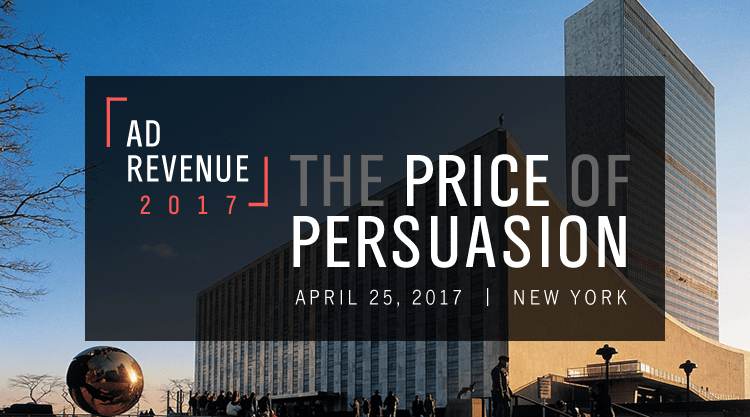Earlier this week, PubMatic convened just over 200 of the operational and executive leaders responsible for driving innovation and shaping the future in programmatic media. They came together for our ninth Ad Revenue conference, held this year at the United Nations Headquarters in NYC. Attendees from as far away as Japan joined for the event and in the discussions on some of the most pressing issues facing digital media and ad tech today. Together we tackled the challenges involved in cutting through the noise to deliver more effective advertising in scalable and repeatable ways—the price of persuasion.
Thought-Provoking Conversations
 To kick off the day, Peter Horan, founder of Horan MediaTech Advisors, led a discussion to understand the seemingly impossible challenge of capturing consumer attention in today’s digital environment. When we place infinite content in front of finite consumers, Aki Spicer, chief digital officer at TBWA, pointed out that relevance has to be our trust currency. To remain effective advertisers, content publishers and service providers must leverage the right data and technology to deliver relevance.
To kick off the day, Peter Horan, founder of Horan MediaTech Advisors, led a discussion to understand the seemingly impossible challenge of capturing consumer attention in today’s digital environment. When we place infinite content in front of finite consumers, Aki Spicer, chief digital officer at TBWA, pointed out that relevance has to be our trust currency. To remain effective advertisers, content publishers and service providers must leverage the right data and technology to deliver relevance.
As to be expected, the price of persuasive storytelling in the current media ecosystem inevitably leads to questions around fees to be paid for technology. We were fortunate to have 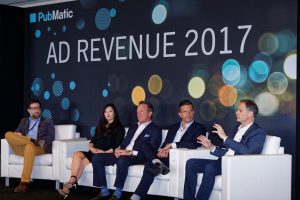 the CEO and founder of Luma Partners, Terry Kawaja, lead this poignant discussion probing into the realities of whether technology costs are a toll gate or are they just the cost of doing business. We are past the point of trying to prove the value of programmatic, and also need to advance our conversations related to the economics of the digital supply chain. Xaxis chairman and president of WPP Digital, David Moore, pointed out that due to the complexity of the digital advertising market, publishers and media buyers need to leverage all the various technologies available to them, because “you are better off getting 40% of something than 100% of nothing.” Eric Franchi,
the CEO and founder of Luma Partners, Terry Kawaja, lead this poignant discussion probing into the realities of whether technology costs are a toll gate or are they just the cost of doing business. We are past the point of trying to prove the value of programmatic, and also need to advance our conversations related to the economics of the digital supply chain. Xaxis chairman and president of WPP Digital, David Moore, pointed out that due to the complexity of the digital advertising market, publishers and media buyers need to leverage all the various technologies available to them, because “you are better off getting 40% of something than 100% of nothing.” Eric Franchi, 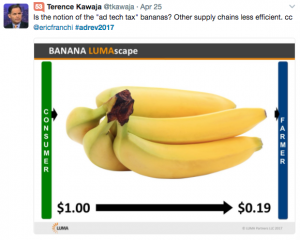 co-founder of Undertone Media, compared the ad tech supply chain to that of the food industry, observing that diners don’t question the cost of every ingredient when they order from the menu, nor do they question how much margin the restaurant is making. He continued to use the food industry supply chain analogy and in response, Terry Kawaja took the challenge to launch the Banana Lumascape at AdRev2017! While a moment of humor, the power of the analogy was not lost. The comparison to other supply chains made it evident that some of the negative sentiments on ad tech are not a fair representation of the value exchange.
co-founder of Undertone Media, compared the ad tech supply chain to that of the food industry, observing that diners don’t question the cost of every ingredient when they order from the menu, nor do they question how much margin the restaurant is making. He continued to use the food industry supply chain analogy and in response, Terry Kawaja took the challenge to launch the Banana Lumascape at AdRev2017! While a moment of humor, the power of the analogy was not lost. The comparison to other supply chains made it evident that some of the negative sentiments on ad tech are not a fair representation of the value exchange.
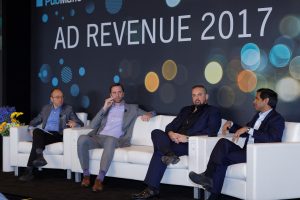 All this and the day was just getting started. IAB president and CEO, Randall Rothenberg, kicked off his session by talking about the need for standards. TAG and MRC certification are becoming requirements for all IAB members in 2018. Seth Rogin, president and CEO of Nucleus Marketing Solutions, explained that if advertisers are buying inventory on 400,000 sites (as JPMorgan Chase did), “it is because they don’t believe in the solution that [premium publishers] are providing,” and our industry need to take responsibility for our careless actions. There’s no way to justify a site list in the tens or hundreds of thousands for effective media buying. The message here was clear: buyers and sellers need to do better if we want to have a clean supply chain.
All this and the day was just getting started. IAB president and CEO, Randall Rothenberg, kicked off his session by talking about the need for standards. TAG and MRC certification are becoming requirements for all IAB members in 2018. Seth Rogin, president and CEO of Nucleus Marketing Solutions, explained that if advertisers are buying inventory on 400,000 sites (as JPMorgan Chase did), “it is because they don’t believe in the solution that [premium publishers] are providing,” and our industry need to take responsibility for our careless actions. There’s no way to justify a site list in the tens or hundreds of thousands for effective media buying. The message here was clear: buyers and sellers need to do better if we want to have a clean supply chain.
The data panel was all about actionable insights. Brad Liebow, 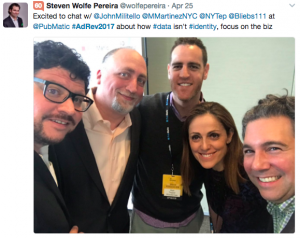 SVP investment for MediaVest, pointed out the obvious fact that understanding the needs and challenges of brands will drive unbelievable results for tech and media companies. However it is still not happening at scale. Chief marketing and communications officer at Neustar, Steven Wolfe Pereira, shined light on the value and importance of data from the marketer’s point of view, and his panel explained the need for brands to shift from being data consumers to data creators in order to rethink how they categorize content and define audiences.
SVP investment for MediaVest, pointed out the obvious fact that understanding the needs and challenges of brands will drive unbelievable results for tech and media companies. However it is still not happening at scale. Chief marketing and communications officer at Neustar, Steven Wolfe Pereira, shined light on the value and importance of data from the marketer’s point of view, and his panel explained the need for brands to shift from being data consumers to data creators in order to rethink how they categorize content and define audiences.
 In a fireside chat with PubMatic VP of advertiser solutions, Kyle Dozeman, Amnet co-CEO, Art Muldoon, explained how his company uses deep programmatic strategies to activate data in a people-based way. The conversation tackled how the shift of brand spend to automated channels has impacted the industry, and the need for new technologies – such as PMPs and the Biddable IO – to hasten the evolution towards quality and transparency.
In a fireside chat with PubMatic VP of advertiser solutions, Kyle Dozeman, Amnet co-CEO, Art Muldoon, explained how his company uses deep programmatic strategies to activate data in a people-based way. The conversation tackled how the shift of brand spend to automated channels has impacted the industry, and the need for new technologies – such as PMPs and the Biddable IO – to hasten the evolution towards quality and transparency.
At PubMatic, we believe that changes in our industry are not just about understanding technology, but about understanding all the perspectives that make our businesses grow. Wenda Harris Millard, vice chairman of MediaLink, led a thought-provoking dialogue 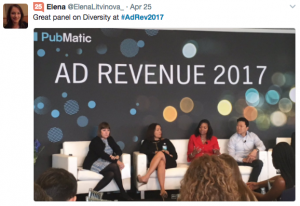 around the competitive advantage that comes from having a diverse mindset within your organization. An expert panel of the leaders driving the diversity conversation within organizations across our ecosystem—Daisy Auger-Dominguez from Viacom, Erika Irish Brown from Bloomberg L.P., Justin Choi from Nativo, and Lucinda Martinez from HBO—explained that everyone, from individual contributors to leaders, can do something to address this issue.
around the competitive advantage that comes from having a diverse mindset within your organization. An expert panel of the leaders driving the diversity conversation within organizations across our ecosystem—Daisy Auger-Dominguez from Viacom, Erika Irish Brown from Bloomberg L.P., Justin Choi from Nativo, and Lucinda Martinez from HBO—explained that everyone, from individual contributors to leaders, can do something to address this issue.
Key Takeaways
Our goal at Ad Revenue this year was to not only stimulate provoking conversations, but to inspire people to take action and change their behavior. There were three key learnings that I think everyone was able to take away from the day’s content:
- Less is the best path to more. At PubMatic, we made the tough decision to resign publishers in the first half of 2016, and it turned out that less was more for our business, providing not only financial results but also a Net Promoter Score increasing from -18% in Q1 2016 to +39% in Q1 2017. Likewise, at Ad Revenue this year, we chose to limit the scale from the multi-hundred person conferences we have done in the past to a more intimate forum appropriate for the hard-hitting conversations that took place at the event. The whole industry needs to follow this example, just as JPMorgan Chase did when they chose to limit their publisher relationships down from 400,000. For example, do publishers really need to have seven header bidding partners? Is that really the best path to drive programmatic sales? The ultimate consideration should be finding the right partners; they should be independent, lead with innovation, and not compete with you for the business you run. Less allows you to move from vendor relationships to truly engaged partnerships that can grow your business.
- Move from vendor relationships to partnerships. It is inevitable that our industry will get smaller through consolidation, and new business models will emerge, signaling a shift from revenue shares to CPM-based pricing. Energy that has historically been devoted to managing a multitude of vendors can be used managing the business growth. There is a need for strategic alignment between a company and their technology partners, and this is where we at PubMatic want to operate. As an industry, we need to move away from casual vendor relationships and start making commitments.
- Trade tactical conversations for strategic planning. At Ad Revenue this year, our goal was to talk about tactics only as they relate to strategic decision making. We all need to broaden our perspectives about how we continue to iterate and operate in order to create the best relationships with our customers and the consumers. This engagement is where we all need to be focusing our energy in order to be best prepared to tackle the challenges of tomorrow.
I would like to extend a heartfelt thank you to our speakers and attendees for what I believe is the best Ad Revenue conference we have had to date, and I look forward to continuing the conversations that began this week – both within PubMatic and with colleagues and contacts across the digital media industry.
